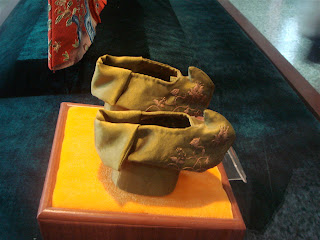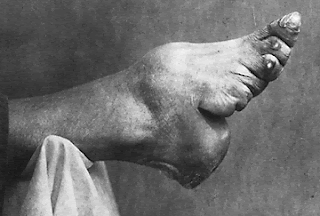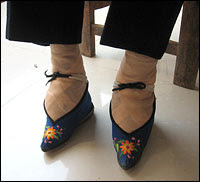
I didn’t know what to expect when it came to shoes in China. The black cloth Mary Jane shoes were the first footwear that came to mind when I thought of this country. But there’s so much to see when touring China that I hardly knew where to look first. And it wasn’t until I had returned home that I realized that I’d only seen one pair of ‘lotus shoes’. Those are the shoes worn by the girls and women who had their feet bound.
We had gone to at least one cultural museum in every city that we visited. In some cities we visited two and maybe three museums and still in all those cultural exhibitions I had only come across one pair of little shoes for those tortured feet. And that pair had been in the museum at the Ming dynasty tombs. But these little shoes looked so new that I’m sure they had been replicas specifically made for the museum.
I was not looking for the bizarre or grotesque. But the outside world had by now heard so much about foot binding that I was certain I’d run into quite a few representations of that aspect of the culture. After all the practice had gone on for hundreds of years and had only been banned in 1911.

I wondered how this strange tradition had begun in the first place. So, I did a little research and found that there were quite a few legends related to the origins of foot binding. The most common legend comes from the Sung dynasty (AD 960-1280). Prince LI Yu’s concubine, Yao Nian was said to walk with such small feet and so gracefully it appeared as if she was “skimming over the top of golden lilies”. From that point on, the ‘lily footed’ woman is said to have become a model for China. There are many variations of another legend regarding an early version of ballet also called toe dancing for the royal court. One particular story is of a dancer who performed on a platform shaped like a lotus blossom. And then there is the legend about the last Empress of the Shang dynasty. This Empress had a clubbed foot and did not want to be known as having this condition. She demanded her husband make binding feet mandatory for all girls. By doing so, her deformed foot could now be considered beautiful. The truth is we may never know the definitive origin of foot binding however the powerful effects of this practice are apparent.
What we do know is that foot binding began in the north and then spread to other parts of China. Eventually all the ladies in the various courts throughout the country adopted this custom that had initially only been practiced by court dancers. Wealthier middle and lower class women followed suite and began to bind their daughters feet, too and ultimately all classes of women participated in this practice. In 1273 the Sung dynasty was taken over by the Mongols and this began the Yuan dynasty. The Mongols supported foot binding for all women because it made the women less likely to be able to succeed. In the 1300’s the Ming dynasty took the place of the Yuan Dynasty and foot binding continued to spread.
The process of foot binding is a torturous experience and began for young girls between the ages of four to six. It was done early in her life so that the arch did not have an opportunity to develop. The mother or sometimes the grandmother started the process in last month of fall or the beginning of winter, so that the foot would be numb from the cold and the pain would not be as severe. The girl’s foot was first soaked in warm water or animal blood and herbs. She would have her toenails cut as short as possible. Her foot was massaged and then the four smallest toes on her foot were broken. A ten foot long silk or cotton bandage that had been soaked in the same liquid in which her feet had been washed was wrapped around her smallest toes and then pulled tightly to the heel. This process was repeated every two days for the next couple of years. At the end of the two years the little girl’s foot would probably only measure three to four inches long. To make sure that the foot stayed small the process of tightly binding the foot continued for at least another 10 years.
Binding women’s feet became an important aspect of the Chinese culture and became much more than just a fashion statement; it crippled women. Foot binding kept women weak, out of power and dominated by her husband. And the process took place so early in a girl’s life that she had no choice but to follow her parent’s wishes. Consequently she’d remain uneducated and would always be seen as an object to men, and the process that had begun as a statement of beauty had in the end defined a society. For hundreds of years bound feet had been a status symbol and the only way for a woman to marry into money. Mothers would demand that a matchmaker find their son a wife with tiny feet. If the mother of a prospective bridegroom lifted the skirt of his intended and found that the woman had ‘clown feet,’ she would not allow her son to marry that woman.
There is a misconception that men found the deformed foot, in the flesh, erotic. Actually men never saw a woman’s bound foot because they were always contained in a ‘lotus shoe’. Some scholars have claimed that the erotic effect was a function of the tiny steps and swaying walk of a woman whose feet had been bound. The very fact that the bound foot was concealed from men’s eyes was, in of itself, sexually suggestive.
In the mid-1600’s the Manchus took over the Yuan dynasty to create the Qing Empire and this new government system strongly opposed foot binding and attempted to prohibit the custom. But by then the practice had become so much a part of the Chinese culture and family traditions, that the government could do little to stop it and the custom continued to thrive even thought it was now considered illegal.
At the onset of the nationalist revolution in 1911, foot binding though not completely disband, was officially made illegal and still a small group of women living in the southern part of China continued the custom.
When the communist came into power in 1949, they issued a ban on foot binding. Much of antiquity was destroyed during those years of revolution. Educators, landlords, businessmen and scholars were forced to work on the land and in the factories. During this time everyone was a common-man. And the women who had bound their feet were seen as the epitome of all that the old ways represented. Any woman who still had her feet bound was forced to remove the bindings and to do hard physical labor alongside her comrades. This work was difficult enough for the ordinary woman, but for the women with the tiny and misshapen feet, it proved to be agonizingly painful.

From what our tour guides told us, China is now trying to change how their country is viewed by the world. There were no apologies for the Mao zealots during the revolution but now the stance seemed to be of one that claims there was an over reaction to bring about change. Our tour of the Ming Tombs where we saw tin boxes that now replaced the actual unearthed coffins that had been destroyed by the youthful fervor of the revolution was a lasting example for me of how much was probably destroyed during that time. Now I understand why so many of those little lotus shoes were nowhere to be seen.
Some scholars estimate that 40 to 50 percent of Chinese women had bound feet in the 19th century. Though for the upper classes, the figure was probably closer to 100 percent. And some estimates say that as many as 2 billion Chinese women broke and bound her feet to attain what was viewed as the ideal of physical perfection.
Now in the era of the one child family though the male child is still the most desired offspring, women are most assuredly making their mark in China. Women are doctors, lawyers, judges and some are even reaching into the political arena. But most assuredly there is no longer foot binding. And though I saw only that one representation of a lotus shoe, I saw women who walked freely on the streets wearing high heels, sandals, slippers, and sneakers. They were wearing shoes of every kind imaginable.

10 comments for “LOTUS FOOT”